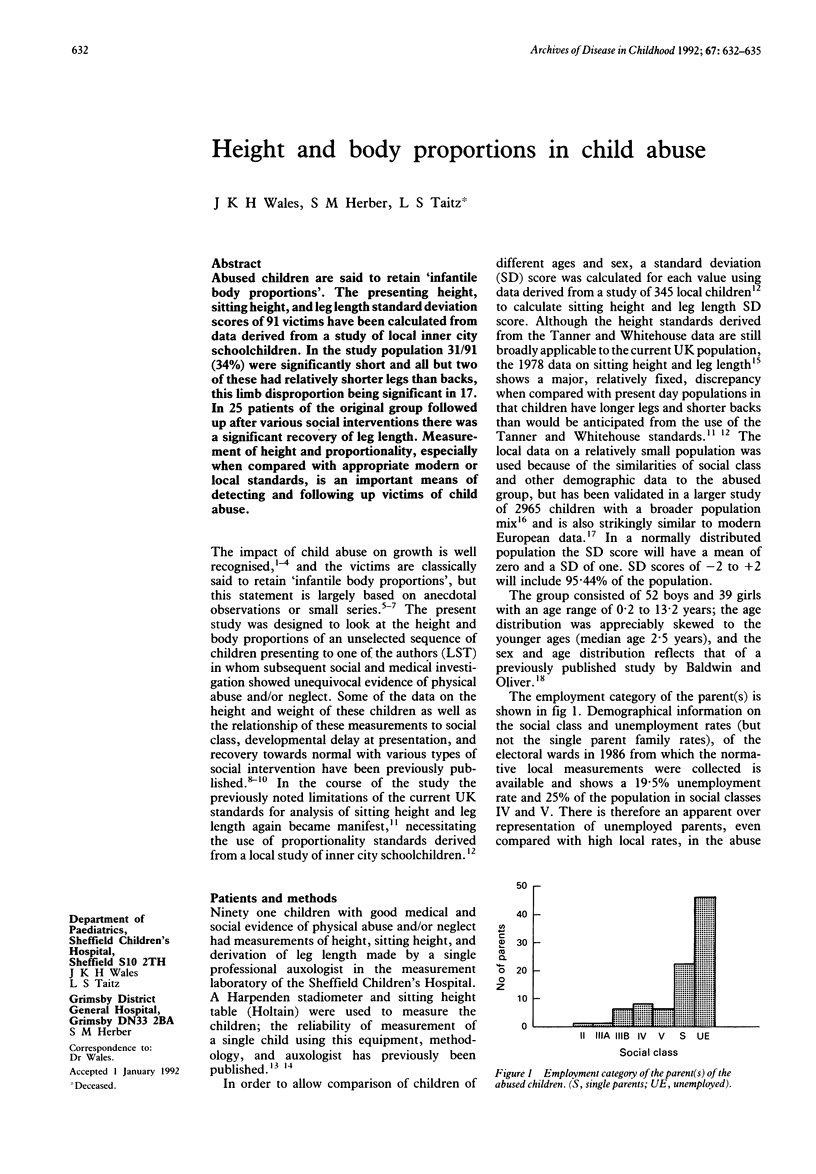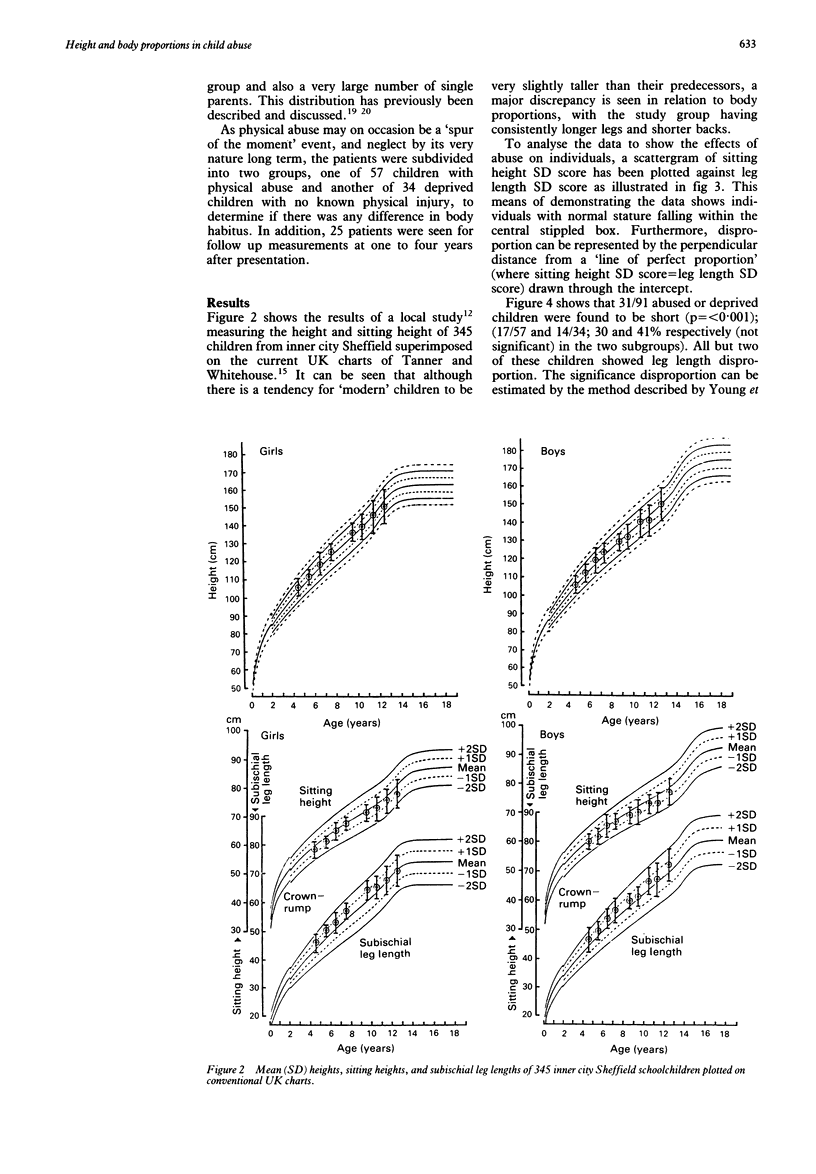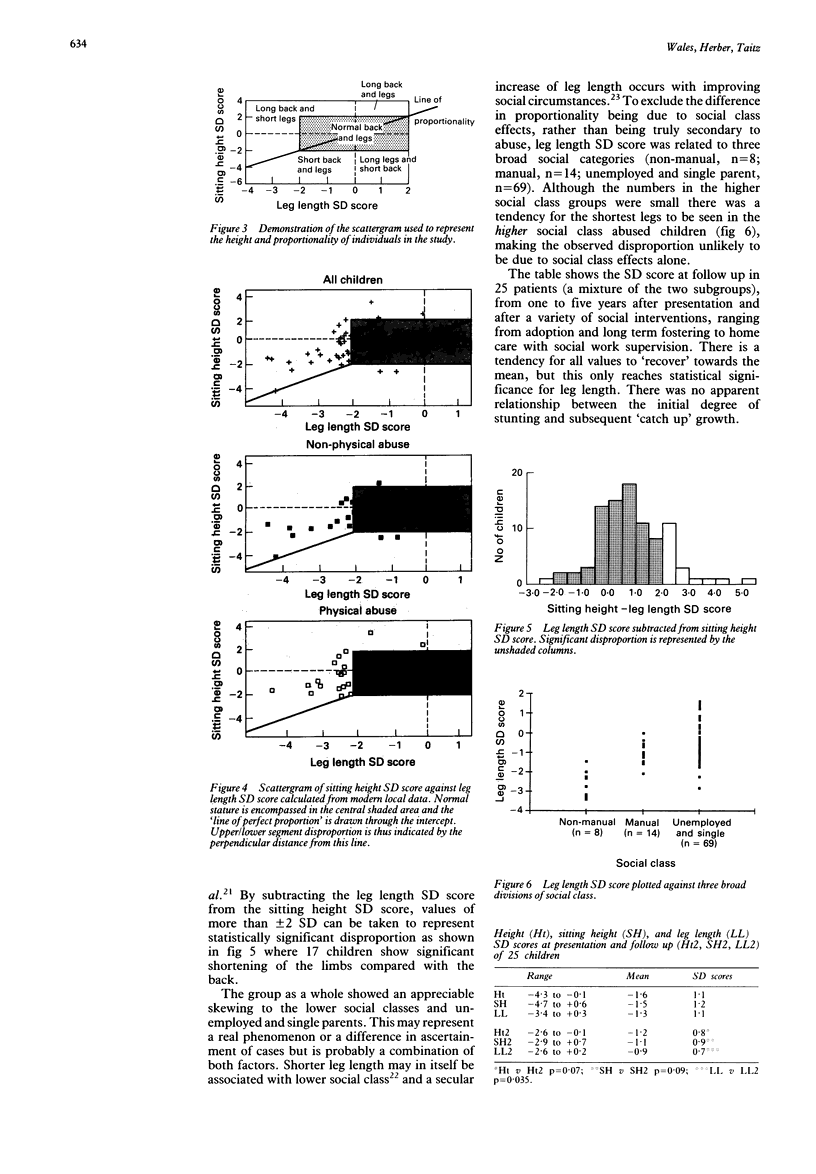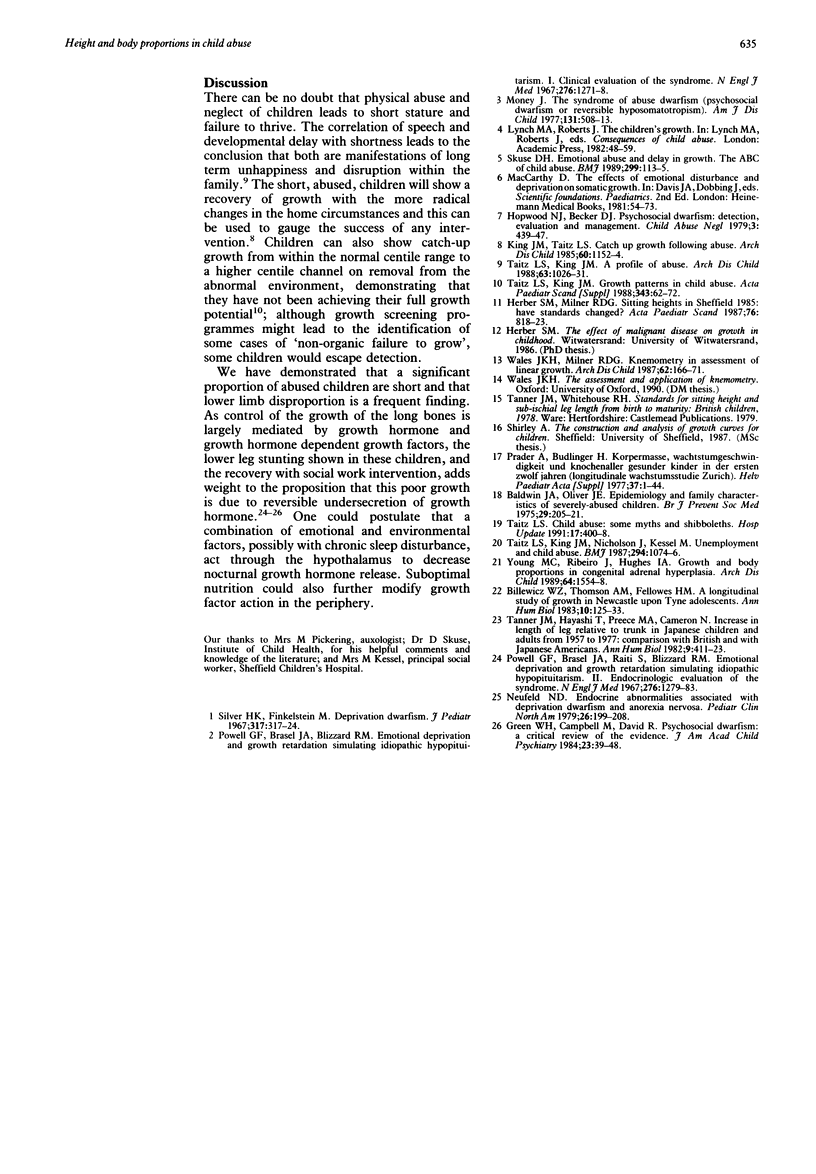Abstract
Abused children are said to retain 'infantile body proportions'. The presenting height, sitting height, and leg length standard deviation scores of 91 victims have been calculated from data derived from a study of local inner city schoolchildren. In the study population 31/91 (34%) were significantly short and all but two of these had relatively shorter legs than backs, this limb disproportion being significant in 17. In 25 patients of the original group followed up after various social interventions there was a significant recovery of leg length. Measurement of height and proportionality, especially when compared with appropriate modern or local standards, is an important means of detecting and following up victims of child abuse.
Full text
PDF



Selected References
These references are in PubMed. This may not be the complete list of references from this article.
- Baldwin J. A., Oliver J. E. Epidemiology and family characteristics of severely-abused children. Br J Prev Soc Med. 1975 Dec;29(4):205–221. doi: 10.1136/jech.29.4.205. [DOI] [PMC free article] [PubMed] [Google Scholar]
- Billewicz W. Z., Thomson A. M., Fellowes H. M. A longitudinal study of growth in Newcastle upon Tyne adolescents. Ann Hum Biol. 1983 Mar-Apr;10(2):125–133. doi: 10.1080/03014468300006271. [DOI] [PubMed] [Google Scholar]
- Green W. H., Campbell M., David R. Psychosocial dwarfism: a critical review of the evidence. J Am Acad Child Psychiatry. 1984 Jan;23(1):39–48. doi: 10.1097/00004583-198401000-00006. [DOI] [PubMed] [Google Scholar]
- Herber S. M., Milner R. D. Sitting heights in Sheffield, 1985: have standards changed? Acta Paediatr Scand. 1987 Sep;76(5):818–823. doi: 10.1111/j.1651-2227.1987.tb10570.x. [DOI] [PubMed] [Google Scholar]
- King J. M., Taitz L. S. Catch up growth following abuse. Arch Dis Child. 1985 Dec;60(12):1152–1154. doi: 10.1136/adc.60.12.1152. [DOI] [PMC free article] [PubMed] [Google Scholar]
- Money J. The syndrome of abuse dwarfism (psychosocial dwarfism or reversible hyposomatotropism). Am J Dis Child. 1977 May;131(5):508–513. doi: 10.1001/archpedi.1977.02120180022002. [DOI] [PubMed] [Google Scholar]
- Neufeld N. D. Endocrine abnormalities associated with deprivational dwarfism and anorexia nervosa. Pediatr Clin North Am. 1979 Feb;26(1):199–208. doi: 10.1016/s0031-3955(16)33680-x. [DOI] [PubMed] [Google Scholar]
- Powell G. F., Brasel J. A., Blizzard R. M. Emotional deprivation and growth retardation simulating idiopathic hypopituitarism. I. Clinical evaluation of the syndrome. N Engl J Med. 1967 Jun 8;276(23):1271–1278. doi: 10.1056/NEJM196706082762301. [DOI] [PubMed] [Google Scholar]
- Powell G. F., Brasel J. A., Raiti S., Blizzard R. M. Emotional deprivation and growth retardation simulating idiopathic hypopituitarism. II. Endocrinologic evaluation of the syndrome. N Engl J Med. 1967 Jun 8;276(23):1279–1283. doi: 10.1056/NEJM196706082762302. [DOI] [PubMed] [Google Scholar]
- Prader A., Budliger H. Körpermasse, Wachstumsgeschwindigkeit und Knochenalter gesunder Kinder in den ersten zwölf Jahren (Longitudinale Wachstumsstudie Zürich) Helv Paediatr Acta. 1977;Suppl 37:1–44. [PubMed] [Google Scholar]
- Skuse D. H. ABC of child abuse. Emotional abuse and delay in growth. BMJ. 1989 Jul 8;299(6691):113–115. doi: 10.1136/bmj.299.6691.113. [DOI] [PMC free article] [PubMed] [Google Scholar]
- Taitz L. S., King J. M. A profile of abuse. Arch Dis Child. 1988 Sep;63(9):1026–1031. doi: 10.1136/adc.63.9.1026. [DOI] [PMC free article] [PubMed] [Google Scholar]
- Taitz L. S., King J. M. Growth patterns in child abuse. Acta Paediatr Scand Suppl. 1988;343:62–72. doi: 10.1111/j.1651-2227.1988.tb10803.x. [DOI] [PubMed] [Google Scholar]
- Taitz L. S., King J. M., Nicholson J., Kessel M. Unemployment and child abuse. Br Med J (Clin Res Ed) 1987 Apr 25;294(6579):1074–1076. doi: 10.1136/bmj.294.6579.1074. [DOI] [PMC free article] [PubMed] [Google Scholar]
- Tanner J. M., Hayashi T., Preece M. A., Cameron N. Increase in length of leg relative to trunk in Japanese children and adults from 1957 to 1977: comparison with British and with Japanese Americans. Ann Hum Biol. 1982 Sep-Oct;9(5):411–423. doi: 10.1080/03014468200005951. [DOI] [PubMed] [Google Scholar]
- Wales J. K., Milner R. D. Knemometry in assessment of linear growth. Arch Dis Child. 1987 Feb;62(2):166–171. doi: 10.1136/adc.62.2.166. [DOI] [PMC free article] [PubMed] [Google Scholar]
- Young M. C., Ribeiro J., Hughes I. A. Growth and body proportions in congenital adrenal hyperplasia. Arch Dis Child. 1989 Nov;64(11):1554–1558. doi: 10.1136/adc.64.11.1554. [DOI] [PMC free article] [PubMed] [Google Scholar]


